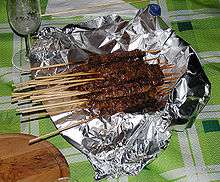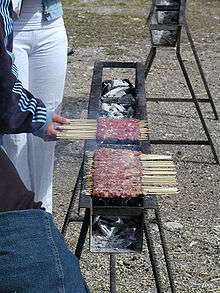Arrosticini


Arrosticini are a class of traditional Abruzzese cuisine from the Italian region of Abruzzo.[1] Arrosticini (rustelle or arrustelle in the local dialects; also known as spierini or spidducc') are typically made from castrated sheep's meat (mutton), cut in chunks and pierced by a skewer. It is cooked on a brazier with a typically elongated shape, called canala as it resembles a gutter.
There are two main kinds of arrosticini: those made industrially, consisting of cubical chunks of meat with a side of 1 cm (1/2.5 inches) on skewers with a maximum length of 10 cm (4 inches); and those made by hand, for which the meat is cut with a knife in chunks of different sizes, alternated on the skewer with pieces of ovine fat (doing so provides more tenderness and a more pleasant smell). This kind of arrosticini requires meat of very high quality because it has to be cooked for a longer time. Arrosticini originate from the food consumed by shepherds and other inhabitants of the mountainous areas in Abruzzo within the villages of Civitella Casanova, Carpineto, and Villa Celiera, who were accustomed to eating even less refined food than hard sheep meat.[2]
Arrosticini are often accompanied by slices of traditionally home-made bread soaked in extra-virgin olive oil (pane unto) with large amounts of peperoncino in olio. The traditional beverage accompaniment is Montepulciano d'Abruzzo wine.
Traditionally, arrosticini are eaten with bare hands, pulling the meat off the skewer piece by piece using one's teeth.
They are produced throughout Abruzzo, both industrially and in a home-made fashion. They are also found in other areas with large populations of Abruzzesi.
See also
Notes
- ↑ Il Devoto-Oli 2014. Vocabolario della lingua Italiana, edited by Luca Serianni and Maurizio Trifone, Le Monnier, 2013.
- ↑ "Enogastronomy". Retrieved 2009-05-03.
External links
| Wikimedia Commons has media related to Arrosticini. |